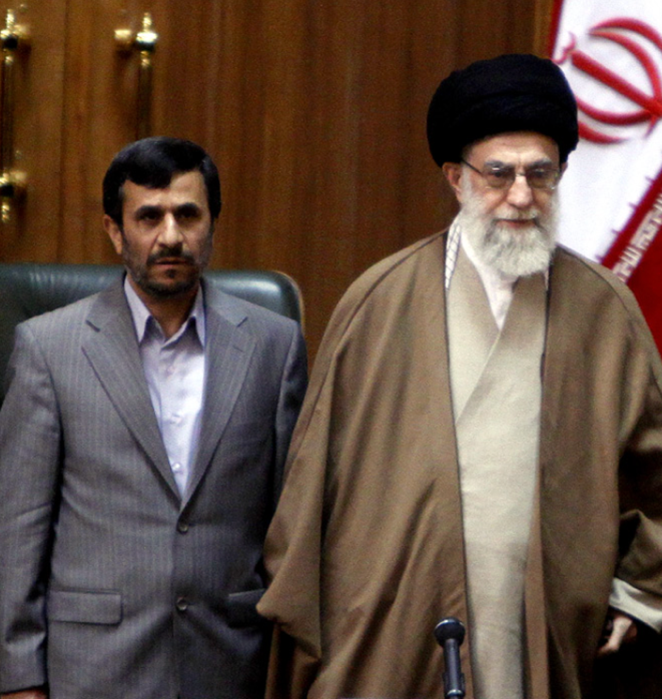Ahmadinejad’s election was one of the greatest triumphs of Khamenei’s tenure as Supreme Leader. The dubious, surprise victory cemented Khamenei’s preeminence over Rafsanjani. Further, his rival was humiliated and exposed as deeply unpopular. For the first time, Khamenei now had a deferential president whose ideology was almost completely aligned with his own. Khamenei was now free to set the national agenda he saw fit without concerns over friction with his president. As such, Ahmadinejad was given wide latitude to speak freely and execute Khamenei’s agenda. With Khamenei’s blessing, Ahmadinejad sought to restore the ideals of Islam and the Islamic Revolution as the basis for policymaking. This entailed elevating the role of the IRGC in public life, abandoning reconciliation and embracing a confrontational approach to the West, aggressively advancing Iran’s nuclear and ballistic missile programs, and seeking to lead unified resistance by the Muslim world against the U.S., Israel, and regional governments allied with the U.S.

Ahmadinejad’s dark-horse victory aroused contempt and derision from middle-class Iranians appalled by his uncouth manner and ignorant statements. Many conservative politicians more aligned with the establishment had their own issues with Ahmadinejad, whose brashness and outsider status threatened their interests. The constant drumbeat of scorn drew his support base of working class, more religiously observant citizens closer to him, as they felt similarly looked down upon by more secular, cosmopolitan cultural elitists.
From the outset, Ahmadinejad set out to take a blowtorch to the domestic and foreign policy agendas of his more liberal predecessors. Ahmadinejad clarified that he saw his mandate as president to restore the Islamic Republic to following the path of Khomeinist principles, particularly when enforcing religious morality in society and countering U.S. and Western imperialism. He had campaigned largely on bread-and-butter economic issues, framing his populist promises for economic redistribution as fulfilling the social justice promises of Khomeini’s revolution. Once in power, however, his primary preoccupations were with national security and Iran’s role in international affairs.
As part of his faithfulness to upholding the principles of the Islamic Revolution, he was devoted to the concept of velayat-e faqih and keen to demonstrate his loyalty to the Supreme Leader. While respectful of Khamenei’s position within the system and aware of the need to stay in his good graces, he was less deferential to the rest of the political establishment, viewing his independence and outsider status as an asset. This led to friction as he tried to assert himself by selecting his men for cabinet positions, leading to the conservative-dominated majles rejecting several of his selections. After much wrangling, he nevertheless succeeded in installing a principlist-heavy cabinet.
Ahmadinejad’s rise would not have been possible without the machinations of the IRGC and basij, and he rewarded them handsomely for their support, most notably by appointing 12 out of his 18 cabinet picks and over half of the provincial governors from the ranks of the IRGC officer corps. Ahmadinejad was the Islamic Republic’s first soldier turned president, and his administration was the catalyst for the overt encroachment of the IRGC into the political sphere. Following efforts during the Khatami administration to weaken the IRGC and break its stranglehold over the economy, the IRGC was no longer mollified by efforts to bribe them out of politics. With Ahmadinejad’s ascent and Khamenei’s blessing, they now had an entrée into the government.
Once entrenched, the IRGC was able to grease the wheels to expand its economic and political power. The president and majles immediately expanded the development budget by 74 percent, creating new opportunities for the IRGC and basij to enrich themselves through energy and infrastructure projects. During the Khatami administration, efforts were made to prevent the IRGC from entering strategic sectors such as petroleum to keep some check on the IRGC’s power, but these restrictions evaporated under Ahmadinejad to the point that the head of Khatam Al-Anbiya (KAA), Rostam Qassemi, was appointed oil minister during his second term. By the end of 2006, the government had steered more than 250 projects to KAA, often through no-bid contracts, including billion-dollar-plus projects to build the Tehran metro, develop oil and natural gas fields, and build a gas pipeline.
Unlike his predecessors, Ahmadinejad insisted there was no need for rapprochement with the “Great Satan,” an assessment shared by Supreme Leader Khamenei. Khamenei felt that improving ties with the U.S. betrayed the Khomeinist ethos. He had reluctantly allowed Khatami and Rafsanjani latitude to explore the prospect. However, efforts to improve relations quickly went up in smoke due to Ahmadinejad’s incendiary rhetoric on the world stage. Khatami had presented a smiling visage and outstretched hand to the West, while Ahmadinejad gave a clenched fist. To many in the West, Ahmadinejad represented the true, militant face of the Islamic Republic, intransigently committed to terrorism, regional destabilization, human rights abuses, and the pursuit of nuclear weapons. Iran’s international image came to be represented by Ahmadinejad’s anti-American, anti-Semitic proclamations and policies, and he drastically eclipsed Khamenei’s public profile.